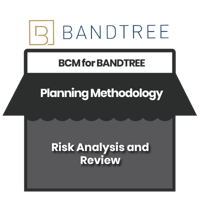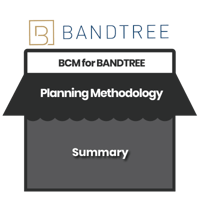Chapter 4
![BCM E2 PM [Business Impact Analysis] Banner](https://blog.bcm-institute.org/hs-fs/hubfs/BCM%20E2%20Blog%20Banner/BCM%20E2%20PM%20%5BBusiness%20Impact%20Analysis%5D%20Banner.png?width=750&height=150&name=BCM%20E2%20PM%20%5BBusiness%20Impact%20Analysis%5D%20Banner.png)
Implementing the Business Impact Analysis (BIA) Phase for Bandtree

The Business Impact Analysis (BIA) is a fundamental phase in the Business Continuity Management (BCM) planning methodology, especially for an organisation like Bandtree.
As a government-linked company specialising in corporate property management under the umbrella of Darussalam Assets Sdn Bhd, Bandtree plays a critical role in the infrastructure and real estate sector of Brunei Darussalam. Given the complexity and importance of its operations, it is crucial to understand the potential impacts of business disruptions on its critical functions.
The purpose of the BIA phase is to identify and assess the potential consequences of business interruptions, with the ultimate goal of developing strategies to ensure continuity and resilience.
By systematically analysing the potential impacts on its operations, Bandtree can prioritise recovery efforts for its most vital functions, thereby safeguarding its reputation, financial stability, and stakeholder relationships.
This chapter examines how the BIA phase is integrated into Bandtree’s BCM planning methodology, with a focus on its eight Critical Business Functions (CBFs).
The process will not only meet the ISO 22301 requirements but will also help Bandtree develop a comprehensive resilience strategy tailored to its unique operational landscape.
BIA Methodology for Bandtree
The BIA phase for Bandtree follows a structured methodology, ensuring all key business functions are systematically assessed for their criticality and potential impact in the event of a disruption.
The approach includes the following steps:
1. Identification of Critical Business Functions (CBFs):
The first step involves identifying Bandtree’s critical business functions, each of which plays a pivotal role in the company’s overall operations. These include:
- CBF-1: Asset & Facilities Management
- CBF-2: Infrastructure Operations
- CBF-3: Client & Stakeholder Management
- CBF-4: Billing, Finance & Vendor Management
- CBF-5: Compliance, Governance & Reporting
- CBF-6: Information Systems & Records Management
- CBF-7: Human Resources & Payroll
- CBF-8: Procurement & Supply Chain Management
2. Impact Assessment:
Once the CBFs are identified, the next step is to assess the potential impact of disruptions on each of these functions.
This involves evaluating the operational, financial, legal, and reputational consequences of a disruption to each of these functions. Specific criteria include:
- Operational Impact: The degree to which a disruption impacts daily operations.
- Financial Impact: The potential financial loss or cost incurred due to a disruption.
- Reputational Impact: The effect on the company’s brand and stakeholder confidence.
- Legal and Compliance Impact: Any risks related to regulatory requirements and legal obligations.
3. Recovery Objectives:
For each critical function, Bandtree will define Recovery Time Objectives (RTO) and Maximum Acceptable Downtime (MAD).
These recovery objectives will serve as a benchmark for the company's response to any disruptions, ensuring that essential functions are restored within acceptable timeframes.
4. Bandtree Considerations:
Bandtree will assess the Asset, Service, Market, People, and Technology (Bandtree) requirements for each CBF:
- Asset: Identifying the critical physical assets (e.g., buildings, equipment) that support each CBF.
- Service: Ensuring that critical services (e.g., client communication, facilities management) are maintained during a disruption.
- Market: Analysing the impact on Bandtree’s market presence and relationships with stakeholders.
- People: Understanding how a disruption could affect key personnel and human resources functions.
- Technology: Evaluating the role of technology in supporting each CBF, especially information systems and records management.
5. Prioritisation and Risk Mitigation:
Based on the impact assessment, each CBF is prioritized according to its criticality to Bandtree’s operations.
Recovery strategies and mitigation measures are then developed for the most vital functions, ensuring that limited resources are allocated effectively to maintain continuity.
Summing Up ...
The Business Impact Analysis phase is a crucial component of Bandtree's Business Continuity Management Planning methodology.
By identifying, assessing, and prioritising critical business functions, Bandtree can ensure that it is well-equipped to respond to disruptions and maintain operational resilience.
This phase is critical not only for ISO 22301 compliance but also for helping Bandtree protect its assets, preserve its reputation, and maintain stakeholder confidence.
Through a rigorous BIA process, Bandtree will gain a comprehensive understanding of its vulnerabilities and will be able to implement recovery strategies that are both effective and efficient.
By embedding resilience into its organisational DNA, Bandtree will be able to safeguard its operations and continue its vital role in Brunei’s infrastructure and real estate sector, even in the face of unexpected challenges.
Resilience Redefined: Implementing BCM at Bandtree Sdn Bhd Brunei |
||||
| eBook 2: Implementing Business Continuity Management |
||||
| C1 | C2 | C3 | C4 | C5 |
 |
 |
 |
 |
 |
| C6 | C7 | C8 | C9 | C10 |
 |
 |
 |
 |
 |





![Register [BL-B-3]*](https://no-cache.hubspot.com/cta/default/3893111/ac6cf073-4cdd-4541-91ed-889f731d5076.png)



![FAQ [BL-B-3]](https://no-cache.hubspot.com/cta/default/3893111/b3824ba1-7aa1-4eb6-bef8-94f57121c5ae.png)
![Email to Sales Team [BCM Institute]](https://no-cache.hubspot.com/cta/default/3893111/3c53daeb-2836-4843-b0e0-645baee2ab9e.png)





